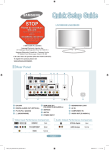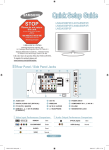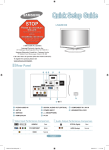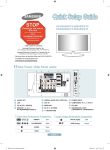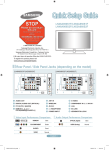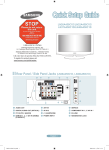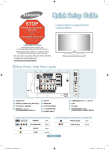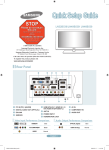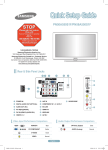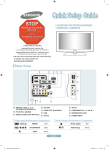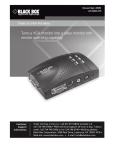Download Samsung LN37A530PF User's Manual
Transcript
Quick Setup Guide LN37A530P1F/LN40A530P1F/ LN46A530P1F/LN52A530P1F 1-800-SAMSUNG (7267864) Samsung Electronics America, Inc. 105 Challenger Road Ridgefield Park, NJ 07660-0511 Samsung Electronics Canada Inc., Customer Service 55 Standish Court Mississauga, Ontario L5R 4B2 Call center hours of operation (Mon-Sun 9AM-12AM EST). To register this product please visit www.samsung.com/global/register. Rear Panel / Side Panel Jacks 1 AUDIO OUT 5 ANT IN 9 SERVICE 2 DIGITAL AUDIO OUT (OPTICAL) 6 AV IN 2 0 COMPONENT IN 1, 2 / AV IN 1 3 PC IN [PC] / [AUDIO] 7 ! EX-LINK 4HDMI IN 1, 2, 3 / DVI IN (HDMI2) 8 POWER INPUT [R-AUDIO-L] HEADPHONE Video Input Performance Comparison @KENSINGTON LOCK Audio Output Performance Comparison / HDMI/DVI Best OPTICAL (Digital) Best / PC/COMPONENT Better AUDIO (Analog) Normal S-VIDEO Good VIDEO Normal English- BN68-01393D-00Eng.indd 1 2008-02-26 ¿ÀÀü 10:03:17 Remote Control See “Remote Control” in the owner’s instructions for details. 1 POWER Turns the TV on and off. % PRE-CH Tunes to the previous channel. 2TV Selects the TV mode directly. ^ CH / CH Press to change channels. 3 NUMERIC BUTTONS Press to change the channel. & SOURCE Press to display and select the available video sources. 4 ress to select additional P channels (digital and analog) being broadcast by the same station. For example, to select channel “54-3”, press “54”, then press “ ” and “3”. 5 (MUTE) ress to temporarily cut off the P sound. 6 VOL – / VOL + Press to increase or decrease the volume. 7 CH LIST Used to display Channel Lists on the screen. 8 TOOLS Use to quickly select frequently used functions. 9 INFO Press to display information on the TV screen. 0 COLOR BUTTONS Use these buttons in the Channel list, etc. ! SRS Selects SRS TruSurround XT mode. @ E.MODE Press to select the preset display and sound modes for sports, cinema and games. # Use these buttons in the DMA, and Anynet+ modes. ( : This remote can be used to control recording on Samsung recorders with the Anynet+ feature) $ ON/OFF Press to backlight the buttons on the remote. This function is convenient for using at night or when the room is dark. (Using the remote control with the ON/OFF light button set to On will reduce the battery usage time.) * CC Controls the caption decoder. ( MENU Displays the main on-screen menu. ) RETURN Returns to the previous menu. a U P▲ / DOWN▼ / LEFT◄ / RIGHT► / ENTER Use to select on-screen menu items and change menu values. b EXIT Press to exit the menu. c DMA (Digital Media Adapter) Use this when connecting a SAMSUNG DMA device through an HDMI interface and switching to DMA mode. For more information on the operating procedures, refer to the user manual of the DMA. This button is available when “Anynet+(HDMI-CEC)” is “On”. d MTS Press to choose stereo, mono or Separate Audio Program (SAP broadcast). e FAV.CH Press to switch to your favorite channels. f P.SIZE Picture size selection. English- BN68-01393D-00Eng.indd 2 2008-02-26 ¿ÀÀü 10:03:18 Connecting a DVD Player or Cable Box/Satellite receiver (Set-Top Box) via HDMI TV Side Panel TV Rear Panel 1 Connect an HDMI Cable between the HDMI IN (1, 2 or 3) jack on the TV and the HDMI jack on the DVD Player or Cable Box/Satellite receiver (Set-Top Box). What is HDMI? •HDMI(High-Definition Multimedia Interface), is an interface that enables the transmission of digital audio and video signals using a single cable. •The difference between HDMI and DVI is that the HDMI device is smaller in size and has the HDCP (High Bandwidth Digital Copy Protection) coding feature installed. DVD Player or Cable Box/ Satellite receiver (Set-Top Box) or 1 HDMI Cable (Not supplied) ➣ Each DVD Player or Cable Box/Satellite receiver (Set-Top Box) has a different back panel configuration. ➣ The TV may not output sound and pictures may be displayed with abnormal color when DVD players/Cable Boxes/Satellite receivers supporting HDMI versions older than 1.3 are connected. When connecting an older HDMI cable and there is no sound, connect the HDMI cable to the HDMI IN 2 jack and the audio cables to the DVI IN (HDMI2) [R-AUDIO-L] jacks on the back of the TV. If this happens, contact the company that provided the DVD player/Cable Box/Satellite receiver to confirm the HDMI version, then request an upgrade. ➣ HDMI cables that are not 1.3 may cause annoying flicker or no screen display. Connecting a DVD Player or Cable Box/Satellite receiver (Set-Top Box) via DVI TV Rear Panel DVD Player or Cable Box/ Satellite receiver (Set-Top Box) 2 Audio Cable (Not supplied) 1 DVI to HDMI Cable (Not supplied) 1 Connect a DVI to HDMI Cable or DVI-HDMI Adapter between the HDMI IN 2 jack on the TV and the DVI jack on the DVD Player or Cable Box/Satellite receiver (Set-Top Box). 2 Connect Audio Cables between the DVI IN (HDMI 2) [R-AUDIO-L] jack on the TV and the DVD Player or Cable Box/Satellite receiver (Set-Top Box). ➣ Each DVD Player or Cable Box/Satellite receiver (Set-Top Box) has a different back panel configuration. ➣ When connecting a DVD Player or Cable Box/Satellite receiver (Set-Top Box), match the color of the connection terminal to the cable. ➣ When using an HDMI/DVI cable connection, you must use the HDMI IN 2 jack. English- BN68-01393D-00Eng.indd 3 2008-02-26 ¿ÀÀü 10:03:19 Connecting a DVD Player or Cable Box/Satellite receiver (Set-Top Box) via Component cables TV Rear Panel DVD Player or Cable Box / Satellite receiver (Set-Top Box) 1 Component Cable (Not supplied) 2 Audio Cable (Not supplied) 1 Connect a Component Cable between the COMPONENT IN (1 or 2) [Y, PB, PR] jacks on the TV and the COMPONENT [Y, PB, PR] jacks on the DVD Player or Cable Box/Satellite receiver (Set-Top Box). 2 Connect Audio Cables between the COMPONENT IN(1 or 2) [R-AUDIO-L] jacks on the TV and the AUDIO OUT jacks on the DVD Player or Cable Box/ Satellite receiver (Set-Top Box). ➣ Component video separates the video into Y (Luminance (brightness)), Pb (Blue) and Pr (Red) for enhanced video quality. Be sure to match the component video and audio connections. For example, if connecting a Component video cable to COMPONENT IN 1, connect the audio cable to COMPONENT IN 1 also. ➣ Each DVD Player or Cable Box/Satellite receiver (Set-Top Box) has a different back panel configuration. ➣ When connecting a DVD Player or Cable Box/Satellite receiver (Set-Top Box), match the color of the connection terminal to the cable. Connecting a Camcorder TV Side Panel Camcoder or 1 1 S-Video cable (Not supplied) 2 Audio cable (Not supplied) Audio cable (Not supplied) 1 Connect a Video Cable (or S-Video Cable) between the AV IN2 [VIDEO] (or S-VIDEO) jack on the TV and the VIDEO OUT jack on the camcorder. 2 Connect Audio Cables between the AV IN2 [R-AUDIO-L] jacks on the TV and the AUDIO OUT jacks on the camcorder. ➣ Each Camcorder has a different back panel configuration. ➣ When connecting a Camcorder, match the color of the connection terminal to the cable. English- BN68-01393D-00Eng.indd 4 2008-02-26 ¿ÀÀü 10:03:21 Connecting a VCR Video Connection TV Side Panel TV Rear Panel VCR Rear Panel 1 Unplug the cable or antenna from the back of the TV. 2 Connect the cable or antenna to the ANT IN terminal on the back of the VCR. 3 4 3 RF Cable (Not supplied) 5 Audio Cable (Not supplied) 4 Video Cable (Not supplied) 5 ➣ Follow the instructions in “Viewing a VCR or Camcorder Tape” to view your VCR tape. Connect an RF Cable between the ANT OUT terminal on the VCR and the ANT IN terminal on the TV. Connect a Video Cable between the VIDEO OUT jack on the VCR and the AV IN 1 [Y/VIDEO] or AV IN 2 [VIDEO] jack on the TV. Connect Audio Cables between the AUDIO OUT jacks on the VCR and the AV IN 1 (or AV IN 2) [R-AUDIO-L] jacks on the TV. If you have a “mono” (non-stereo) VCR, use a Y-connector (not supplied) to connect to the right and left audio input jacks of the TV. Alternatively, connect the cable to the “R” jack. If your VCR is stereo, you must connect two cables. ➣ Each VCR has a different back panel configuration. ➣ When connecting a VCR, match the color of the connection terminal to the cable. ➣ When connecting to AV NI 1, the color of the AV IN 1 [Y/VIDEO] jack (Green) does not match the color of the video cable (Yellow). S-Video Connection TV Side Panel TV Rear Panel 1 To begin, follow steps 1–3 in the previous section to connect the antenna or cable to your VCR and your TV. 2 Connect an S-Video Cable between the S-VIDEO OUT jack on the VCR and the AV IN 2 [S-VIDEO] jack on the TV. 3 Connect Audio Cables between the AUDIO OUT jacks on the VCR and the AV IN 2 [R-AUDIO-L] jacks on the TV. VCR Rear Panel 1 RF Cable (Not supplied) 2 S-Video Cable (Not supplied) 3 Audio Cable (Not supplied) An S-Video cable may be included with a VCR. (If not, check your local electronics store.) ➣ Each VCR has a different back panel configuration. ➣ When connecting a VCR, match the color of the connection terminal to the cable. English- BN68-01393D-00Eng.indd 5 2008-02-26 ¿ÀÀü 10:03:22 Connecting a Digital Audio System 1 TV Rear Panel Digital Audio System Connect an Optical Cable between the “DIGITAL AUDIO OUT (OPTICAL)” jacks on the TV and the Digital Audio Input jacks on the Digital Audio System. When a Digital Audio System is connected to the “DIGITAL AUDIO OUT (OPTICAL)” jack: Decrease the volume of the TV and adjust the volume level with the system’s volume control. 1 ➣ 5.1CH audio is possible when the TV is connected to an external device supporting 5.1CH. Optical Cable (Not supplied) ➣ Each Digital Audio System has a different back panel configuration. ➣ When the receiver (home theater) is set to On, you can hear sound output from the TV’s Optical jack. When the TV is displaying a DTV(air) signal, the TV will send out 5.1 channel sound to the Home theater receiver. When the source is a digital component such as a DVD and is connected to the TV via HDMI, only 2 channel sound will be heard from the Home Theater receiver. If you want to hear 5.1 channel audio, connect the DIGITAL AUDIO OUT (OPTICAL) jack on the DVD player or Cable/Satellite Box directly to an Amplifier or Home Theater, not the TV. Connecting an Amplifier/DVD Home Theater 1 TV Rear Panel Amplifier/DVD Home Theater Connect Audio Cables between the AUDIO OUT [R-AUDIO-L] jacks on the TV and AUDIO IN [R-AUDIO-L] jacks on the Amplifier/DVD Home Theater. When an audio amplifier is connected to the “AUDIO OUT [R-AUDIO-L]” jack: Decrease the volume of the TV and adjust the volume level with the Amplifier’s volume control. ➣ Each Amplifier/DVD Home Theater has a different back panel configuration. 1 ➣ When connecting an Amplifier/DVD Home Theater, match the color of the connection terminal to the cable. Audio Cable (Not supplied) English- BN68-01393D-00Eng.indd 6 2008-02-26 ¿ÀÀü 10:03:24 Connecting a PC Using the D-Sub Cable Using the D-Sub Cable TV Rear Panel 1 D-Sub Cable (Not supplied) 2 PC Audio Cable (Not supplied) PC Using the HDMI/DVI Cable TV Rear Panel 1 Connect a D-Sub Cable between PC IN [PC] connector on the TV and the PC output connector on your computer. 2 Connect a PC Audio Cable between the PC IN [AUDIO] jack on the TV and the Audio Out jack of the sound card on your computer. Using the HDMI/DVI Cable 1 Connect an HDMI/DVI cable between the HDMI IN 2 jack on the TV and the PC output jack on your computer. 2 Connect a 3.5 mm Stereo miniplug/2RCA Cable between the DVI IN(HDMI2) [R-AUDIO-L] jack on the TV and the Audio Out jack of the sound card on your computer. ➣ Each PC has a different back panel configuration. ➣ When connecting a PC, match the color of the connection terminal to the cable. 1 2 HDMI/DVI Cable (Not supplied) PC ➣ When using an HDMI/DVI cable connection, you must use the HDMI IN 2 terminal. 3.5 mm Stereo mini-plug/ 2RCA Cable (Not supplied) English- BN68-01393D-00Eng.indd 7 2008-02-26 ¿ÀÀü 10:03:25 Turning the TV On and Off 4 Press the POWER button on the remote control. You can also use the POWER button on the TV. Viewing the Menus When selecting the Cable TV system: Press the ENTER button to start the auto program. Press the ▲,▼, ◄ or ► to select the correct analog signal cable system source among “STD”, “HRC”, and “IRC”. Press the ▲ or ▼ button to select “Start”, then press the ENTER button. If you have Digital cable TV, select the cable system signal source for both Analog and Digital. Auto Program Selects the cable system. 1 With the power on, press the MENU button. The main menu appears on the screen. The menu’s left side has icons: Picture, Sound, Channel, Setup, Input, Application. 2 Press the ▲ or ▼ button to select one of the icons. Then press the ENTER button to access the icon’s sub-menu. Press the EXIT button to exit. HRC IRC Digital STD HRC IRC Start 5 Enter Return The TV begins memorizing all available stations. Press the EXIT button to exit. Auto Program Auto Program in Progress. Cable 11 3% DTV Cable : -- Cable : -- Stop Storing Channels in Memory (Automatic Method) Enter 1 Press the MENU button to display the menu. Press the ▲ or ▼ button to select “Channel”, then press the ENTER button. 2 Press the ▲ or ▼ button to select “Auto Program”, then press the ENTER button. 3 Press the ▲ or ▼ button to select the antenna connection, then press the ENTER button. Auto Program Return To Stop the Auto Program Function Select the Antenna source to memorize. Air Start Cable Start Auto Start Enter STD Move ➣ The on-screen menus disappear from the screen after about one minute. Move Analog Press the MENU button while the Auto Program function is being executed. You can also press the ENTER button to stop the setup. Return Checking to see if Channels were Stored in Memory Press the CH button. Only the channels stored in memory will be selected (in order). Selecting the antennas • Air: “Air” antenna signal. • Cable: “Cable” antenna signal. • Auto: “Air” and “Cable” antenna signals. English- BN68-01393D-00Eng.indd 8 2008-02-26 ¿ÀÀü 10:03:26 Setting the Channel List Picture Mode You can delete or add a channel to display the channels you want. 1 Press the MENU button. Press the ▲ or ▼ button to select “Channel”, then press the ENTER button. Press the ▲ or ▼ button to select “Channel List”, then press the ENTER button. 2 Press the ◄ button to select “Added Channels”. Press the ▲ or ▼ button to select “All Channels”. Press the ENTER button. 3 Press the ▲ or ▼ button to select a channel to delete, then press the TOOLS button. Press the ENTER button to select “Delete”. 4 Press the ▲ or ▼ button to select a channel to add, then press the TOOLS button. Press the ENTER button to select “Add”. All Channels 2 Air 4 4-2 Air Air 13 Air 13-1 ♥ TV #3 Air Antenna Customizing the Picture Settings Your television has several setting options that allow you to control the picture quality. 1 To select the desired picture mode, follow the “Changing the Picture Standard” instructions numbers 1 and 2. 2 Press the ▲ or ▼ button to select “Backlight”, “Contrast”, “Brightness”, “Sharpness”, “Color” or “Tint(G/R)”, then press the ENTER button. 3 ress the ◄ or ► button to decrease or increase P the value of a particular item. Press the EXIT button to exit. Delete Add to Favorite ♥ TV #8 8 •D ynamic: Selects the picture for high-definition in a bright room. •S tandard: Selects the picture for the optimum display in a normal environment. •M ovie: Selects the picture for viewing movies in a dark room. Timer Viewing Channel Name Edit Auto Program M. Spillane’s mike Hammer Zoom Select TOOLS ➣ W hen you make changes to “Backlight”, “Contrast”, “Brightness”, “Sharpness”, “Color” or “Tint(G/R)”, the OSD will be adjusted accordingly. Option ➣ In PC mode, you can only make changes to “Backlight”, “Contrast” and “Brightness”. Changing the Picture Standard You can select the type of picture which best corresponds to your viewing requirements. 2 Press the ENTER button to select “Mode”. Press the ▲ or ▼ button to select “Dynamic”, “Standard” or “Movie”. Press the ENTER button. Picture 1 Press the MENU button to display the menu. Press the ENTER button, to select “Picture”. ➣ Settings can be adjusted and stored for each external device you have connected to an input of the TV. Mode : Standard Backlight : 7 Contrast : 95 Brightness : 45 Sharpness : 50 Color : 50 Tint (G/R) : G50/R50 ► Detailed Settings Picture Option Picture Mode :Standard Dynamic Backlight Contrast : 7Standard Movie : 95 Brightness : 45 Sharpness : 50 Color : 50 Tint (G/R) : G50/R50 ► Backlight Move 7 Adjust Enter Return Picture Adjustment Detailed Settings •B acklight: Adjusts the brightness of LCD back light. •C ontrast: Adjusts the contrast level of the picture. •B rightness: Adjusts the brightness level of the picture. •S harpness: Adjusts the edge definition of the picture. •C olor: Adjusts color saturation of the picture. •T int(G/R): Adjusts the color tint of the picture. English- BN68-01393D-00Eng.indd 9 2008-02-26 ¿ÀÀü 10:03:26 To Select the Source TV AV1 ---- AV2 ---- S-Video ---- Component1 ---- Component2 ---- PC Refresh ---TOOLS Option Press the SOURCE button on the Remote Control You can select the TV mode or an input source connected to the TV set. Use this button to choose an input source that you would like to watch. ➣ Available signal sources: TV, AV1, AV2, S-Video, Component1, Component2, PC, HDMI1, HDMI2/DVI, HDMI3. ➣ You can choose only those external devices that are connected to the TV. In the “Source List”, connected inputs will be highlighted and sorted to the top. Inputs that are not connected will be sorted to the bottom. ➣ Using the Color buttons on the remote with the Source list • Red (Refresh): Refreshes the connecting external devices. • TOOLS (Option): Displays the “Edit Name” and “Information” menus. English-10 BN68-01393D-00Eng.indd 10 2008-02-26 ¿ÀÀü 10:03:27 Troubleshooting If the TV seems to have a problem, first try this list of possible problems and solutions. If none of these troubleshooting tips apply, call Samsung customer service at 1-800-SAMSUNG. Problem Possible Solution Poor picture Try another channel. / Adjust the antenna. / Check all wire connections. Poor sound quality. Try another channel. / Adjust the antenna. No picture or sound. Try another channel. / Press the SOURCE button. / Make sure the TV is plugged in. / Check the antenna connections. No sound or sound is too low at maximum volume. First, check the volume of units connected to your TV (digital broadcasting receiver, DVD, cable broadcasting receiver, VCR, etc.). Then, adjust the TV volume accordingly. Picture rolls vertically. Check all wire connections. The TV operates erratically. Unplug the TV for 30 seconds, then try operating it again. The TV won’t turn on. Make sure the wall outlet is working. Remote control malfunctions Replace the remote control batteries. Clean the upper edge of the remote control (transmission window). Check the battery terminals. “Check signal cable” message. Ensure that the signal cable is firmly connected to the PC source. “Not Supported Mode” message. Check the maximum resolution and connected device’s Video frequency. Compare these values with the data in the Display Modes. Digital broadcasting screen problem. Please check the digital signal strength and input antenna. The image is too light or too dark. Adjust the Brightness and Contrast. / Adjust the Fine tuning. Black bars on the screen. Make sure the broadcast you’re receiving is High Definition (HD). HD channels sometimes broadcast Standard Definition (SD) programming, which can cause black bars. Set your cable/satellite box to stretch or widescreen mode to eliminate the bars. Picture has a Red/Green or Pink tint. Make sure the Component cables are connected to the correct jacks. Closed Captioning not working. If you are using a Cable/Satellite box, you must set Closed Captioning on the box, not your TV. Snowy picture. Your cable box may need a firmware upgrade. Please contact your Cable company. Ghosting on picture This is sometimes caused by compatibility issues with your cable box. Try connecting Component cables instead. Horizontal bars appear to flicker, jitter or shimmer on the image. Adjust the Coarse tuning and then adjust the Fine tuning. Vertical bars appear to flicker, jitter or shimmer on the image. Adjust the Coarse tuning and then adjust the Fine tuning. Screen is black and power indicator light blinks steadily. On your computer check: Power, Signal Cable. The TV is using its power management system. Move the computer's mouse or press any key on the keyboard. Image is not centered on the screen. Adjust the horizontal and vertical position. The screen position must be adjusted on the output source (i.e. STB) with a digital signal. The picture appears distorted in the corner of the screen. If "Just Scan" is selected with some external devices, the picture may appear distorted in the corner of the screen. This symptom is caused by the external devices, not TV. The "Resets all settings to the default values" message appears. This appears when you press and hold the EXIT button for a while. The product settings are reset to the factory defaults. English-11 BN68-01393D-00Eng.indd 11 2008-02-26 ¿ÀÀü 10:03:27 Guide d'installation rapide sTOP LnA0P1F/Ln0A0P1F/ LnA0P1F/LnA0P1F VeuillezsVPnepas retournercetappareil. En cas de problèmes de fonctionnement, veuillez composer le numéro suivant : 1-00-sAmsunG(1-00--) Pour obtenir de l’assistance en ligne, allez au lien suivant : www.samsung.com/support 1-800-SAMSUNG (7267864) Samsung Electronics America, Inc. 105 Challenger Road Ridgefield Park, NJ 07660-0511 Samsung Electronics Canada Inc., Customer Service 55 Standish Court Mississauga, Ontario L5R 4B2 Centre d’appel – heures de service (du lundi au dimanche, de 9 h à 12 h (HNE) Pour enregistrer ce produit, veuillez SVP aller à : www.samsung.com/global/register. Panneauarrière/Prisesdupanneaulatéral 1 AuDiOOuT 5 AnTin 9 sERViCE 2 DiGiTALAuDiOOuT(OPTiCAL) 6 AVin/s-ViDEO 0 COmPOnEnTin1,/AVin1 3 PCin[PC]/[AuDiO] 7 ! EX-LinK 4 HDmiin1,,/DViin(HDmi) 8 PuissAnCECOnsOmméE [R-AuDiO-L] éCOuTEuRs Entréevidéo–tableaucomparatifdesperformances @ VERROuKEnsinGTOn sortieaudio–tableaucomparatifdesperformances / HDmi/DVi La meilleure OPTiCAL(numérique) La meilleure / PC/COmPOnEnT Excellente AuDiO(analogique) Normale s-ViDéO Bonne ViDéO Normale Français-1 BN68-01393D-00Fre.indd 1 2008-02-26 ¿ÀÀü 10:03:53 Télécommande Reportez-vous à la section "Télécommande" du guide de l’utilisateur pour plus de détails. 1 POWER % PRE-CH Permet d’allumer et d’éteindre le Permet d’écouter le canal téléviseur. précédent. 2 T V ^ CH / CH Pour sélectionner directement le Permettent de changer de canal. mode TV. & SOURCE 3 Boutons numériques Appuyer sur cette touche pour Permet de changer de chaîne. afficher et choisir les sources vidéo accessibles. 4 Appuyez sur ce bouton pour * CC sélectionner des canaux Permet de commander la supplémentaires (numériques fonction de sous-titrage. et analogiques) diffusées par la même station. Par exemple, ( MENU pour sélectionner le canal “54Affiche le menu à l’écran principal. 3”, appuyez sur “54”, puis sur “ ” et sur “3”. ) RETURN Retourne au menu précédent. 5 (MUTE) Permet de couper le son temporairement et de le rétablir. a H AUT▲/BAS▼/GAUCHE◄/ DROITE►/ ENTER Autiliser pour sélectionner les 6 VOL – / VOL + éléments du menu à l’écran et Appuyer sur ces touches pour modifier les valeurs du menu. augmenter ou diminuer le volume. b EXIT 7 CH LIST Appuyer sur cette touche pour Afficher la liste des canaux à sortir du menu. l’écran. c DMA (adaptateur pour les 8 TOOLS supports numériques) Permettent de sélectionner les Utiliser cette fonction lorsqu’un fonctions fréquemment utilisées. appareil DMA de SAMSUNG 9 INFO est branché à une interface Appuyez sur cette touche pour HDMI ou que le téléviseur afficher de l’information à l’écran. est en mode DMA. Pour plus d’information sur les procédures 0 TOUCHES DE COULEUR d’utilisation, consulter le guide Utiliser ces touches à partir de la de l’utilisateur du dispositif DMA. liste des canaux, etc. Cette touche est active lorsque le mode “Anynet+(HDMI-CEC)” ! SRS est activé. Selects SRS TruSurround XT mode. d MTS Appuyez sur ce bouton pour @ E.MODE choisir Stéréo, Mono ou Appuyer sur cette touche pour Programme audio séparé sélectionner l’affichage préréglé (Diffusion de programme audio et les modes sonores pour les séparé). sports, le cinéma et les jeux. e FAV.CH # Utiliser ces touches pour les Appuyez sur ce bouton pour modes DMA et Anynet+. naviguer entre vos chaînes ( : Cette télécommande favorites. peut servir à commander l’enregistrement sur des enregistreurs Samsung avec la f P.SIZE Permet de sélectionner la taille fonction Anynet+.) d’image. $ ON/OFF Appuyer sur cette touche pour rétroéclairer les touches de la télécommande. Cette fonction est utile durant la nuit ou lorsque la pièce est sombre. (L’utilisation de la télécommande alors que la touche ON/OFF est réglée à On réduit le temps d’utilisation des piles.) Français- BN68-01393D-00Fre.indd 2 2008-02-26 ¿ÀÀü 10:03:54 Connexion d’un lecteur DVD ou d’un décodeur Câble/récepteur satellite (boîtier décodeur) via HDMI Panneau latéral de la télévision Pannear arrière de la télévision 1 Branchez un Câble HDMI entre la prise HDMI IN (1, 2 ou 3) du téléviseur et la prise HDMI du lecteur DVD ou du décodeur Câble/récepteur satellite (boîtier décodeur). Qu’est-ce que le mode HDMI ? •HDMI ou high-definition multimedia interface (interface multimédia haute définition) est une interface de nouvelle génération qui permet la transmission de signaux numériques audio et vidéo à l’aide d’un simple Câble et sans compression. Lecteur DVD ou décodeur Câble/ récepteur satellite (boîtier décodeur) •La différence entre les interfaces HDMI et DVI réside dans le fait que la HDMI est de plus petites dimensions, qu’elle est dotée du composant de codage HDCP (protection contre la copie numérique à large bande passante). ou 1 Câble HDMI (non fourni) ➣ La configuration du panneau arrière de chaque lecteur DVD ou de chaque décodeur Câble/récepteur satellite (boîtier décodeur) diffère. ➣ Le téléviseur peut n’émettre aucun son et les images peuvent s’afficher avec une couleur anormale lorsque des lecteurs DVD/décodeurs/ récepteurs satellite avec des versions du mode HDMI antérieures à HDMI 1.3 sont branchés. Lorsque vous branchez un Câble HDMI doté d’une version antérieure et qu’aucun son n’est émis, branchez le Câble HDMI à la prise HDMI IN 2 et les câbles audio aux prises DVI IN (HDMI2) [R-AUDIO-L] situées à l’arrière du téléviseur. Dans ce cas, contactez la société qui fournit le lecteur DVD/décodeur Câble/récepteur satellite afin de confirmer votre version HDMI, puis demandez une mise à jour. ➣ Les câbles HDMI qui ne sont pas de version 1.3 peuvent provoquer des nuisances à l’écran ou une absence d’image. Connexion d’un lecteur DVD ou d’un décodeur Câble/récepteur satellite (boîtier décodeur) via DVI Pannear arrière de la télévision DVD ou du décodeur Câble/ récepteur satellite (boîtier décodeur) 2 Câble Audio (non fourni) 1 Câble DVI vers HDMI (non fourni) 1 Branchez un Câble DVI vers HDMI ou un adaptateur DVI-HDMI entre la prise HDMI IN 2 du téléviseur et la prise DVI du lecteur DVD ou du décodeur Câble/récepteur satellite (boîtier décodeur). 2 Branchez les câbles audio entre la prise DVI IN (HDMI 2) [R-AUDIO-L] du téléviseur et le lecteur DVD ou le décodeur Câble/récepteur satellite (boîtier décodeur). ➣ La configuration du panneau arrière de chaque lecteur DVD ou de chaque décodeur Câble/récepteur satellite (boîtier décodeur) diffère. ➣ Lorsque vous branchez un lecteur DVD ou un décodeur Câble/récepteur satellite (boîtier décodeur), faites correspondre les couleurs de la borne de connexion à celles du Câble. ➣ La prise d’entrée HDMI IN 2 doit être utilisée pour un branchement de Câble HDMI/DVI. Français- BN68-01393D-00Fre.indd 3 2008-02-26 ¿ÀÀü 10:03:56 Branchement d’un lecteur DVD, câblosélecteur ou récepteur satellite à l’aide de câbles composantes Pannear arrière de la télévision Lecteur DVD ou décodeur Câble/ récepteur satellite (boîtier décodeur) 1 Câble composante (non fourni) 2 Câble Audio (non fourni) 1 Branchez un Câble composant entre les prises COMPONENT IN (1 ou 2) [Y, PB, PR] du téléviseur et les prises COMPONENT [Y, PB, PR] du lecteur DVD ou du décodeur Câble/récepteur satellite (boîtier décodeur). 2 Branchez les câbles audio entre les prises COMPONENT IN (1 ou 2) [R-AUDIO-L] du téléviseur et les prises AUDIO OUT du lecteur DVD ou du décodeur Câble/récepteur satellite (boîtier décodeur). ➣ La composante vidéo sépare la vidéo entre Y (Luminosité), Pb (Bleu) et Pr (Rouge) pour une qualité vidéo accrue. Assurez-vous de faire correspondre la composante vidéo et les connexions audio. Par exemple, si un Câble vidéo Composante est branché à la prise d’entrée COMPONENT IN 1, le Câble audio doit être branché à la prise d’entrée COMPONENT IN 1 également. ➣ La configuration du panneau arrière de chaque lecteur DVD ou de chaque décodeur Câble/ récepteur satellite (boîtier décodeur) diffère. ➣ Lorsque vous branchez un lecteur DVD ou un décodeur Câble/récepteur satellite (boîtier décodeur), faites correspondre les couleurs de la borne de connexion à celles du Câble. 1 Connectez un Câble Vidéo (ou Câble S-Vidéo) entre les prises AV IN2 [VIDEO] (ou S-VIDEO) du téléviseur et les prises A UDIO OUT du caméscope. 2 Connectez un Câble Audio entre les prises AV IN 2 [R-AUDIO-L] du téléviseur et les prises AUDIO OUT du caméscope. Connexion d’un caméscope Panneau latéral de la télévision Caméscope ou 1 1 S-Câble Vidéo (non fourni) 2 Câble Audio (non fourni) Câble Vidéo (non fourni) ➣ La configuration arrière de chaque caméscope est différente suivant les appareils. ➣ Lorsque vous connectez un caméscope, faites correspondre les couleurs de la borne et du Câble. Français- BN68-01393D-00Fre.indd 4 2008-02-26 ¿ÀÀü 10:03:57 Branchement d’un magnétoscope Connexion vidéo Panneau latéral de la télévision Pannear arrière de la télévision Panneau arriére du magnétoscope 1 Débranchez l’antenne ou le Câble de l’arrière de la télévision. 2 Branchez le Câble ou l’antenne à la prise ANT IN située à l’arrière du magnétoscope. 3 4 3 Câble RF (non fourni) 5 Câble Audio (non fourni) 4 Câble Vidéo (non fourni) 5 ➣ Suivez les instructions de “Visualisation d’une cassette à l’aide d’un magnétoscope ou d’un caméscope” pour visualiser une cassette à l’aide de votre magnétoscope. ➣ La configuration arrière de chaque magnétoscope est différente suivant les appareils. ➣ Lorsque vous connectez un magnétoscope, faites correspondre les couleurs de la borne et du Câble. Relier au moyen d’un Câble RF la borne ANT OUT du magnétoscope et la borne ANT IN du téléviseur. Relier au moyen d’un Câble vidéo la prise de sortie vidéo du magnétoscope et la prise AV IN 1 [Y/VIDEO] ou AV IN 2 [VIDEO] du téléviseur. Branchez les Câbles Audio entre les prises AUDIO OUT du magnétoscope et les prises AV IN 1 (ou AV IN
This document in other languages
- français: Samsung LN37A530PF

























